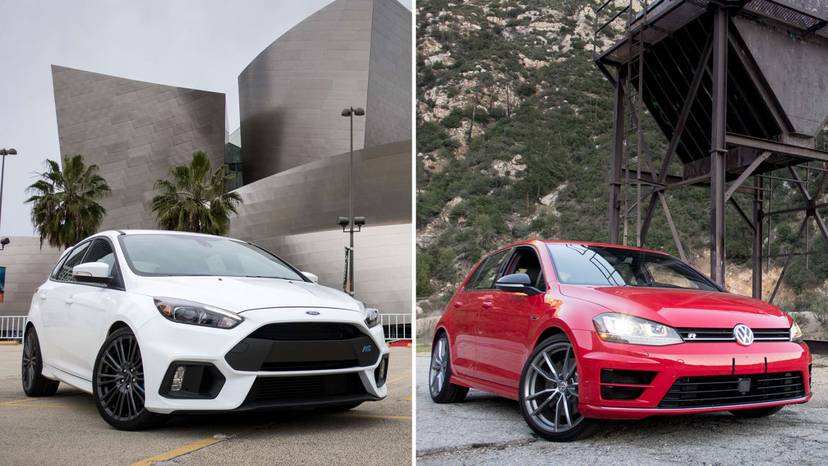
You have to admire what Volkswagen has done with the Golf compact car. It’s had the same basic shape and mission since its inception in the mid-1970s, when it was created by VW as a more modern successor to the Beetle. It’s always been an upright hatchback design meant to maximize utility and comfort, but the Golf has also always brought a certain level of driving engagement that most compact cars can’t come close to touching.
The fact that VW makes two sport-minded variants of the Golf is even better. I’ve called the front-wheel-drive Golf GTI the world’s perfect all-around enthusiast car; it’s that good. So does it make sense to spend more money for a more powerful Volkswagen Golf, one equipped with standard all-wheel drive, an adaptive suspension and more aggressive styling? Is the Golf R a superfluous addition to the top of the Golf range, or is it a GTI “turned up to 11” — worth more than its sticker price suggests?
Exterior and Styling
$$IMAGE-1,3,4,5,6,7,8$$
From the outside, the Volkswagen Golf R doesn’t look much different from the GTI. VW has never been one to embellish its clean designs with unnecessary add-on frippery, and the Golf R maintains that minimalist hot hatch look. There’s a new bumper with larger air inlets, plus an “R” logo in the grille. The car has a stanced look, sitting 0.8 inch lower than a standard Golf on its sport suspension and 0.2 inch lower than a GTI, making the big, 18-inch wheels that are unique to the R fill the wheel wells even better. Out back, we have a unique diffuser, a minimum of badging and quad tailpipes to let the rorty sound out. The visual changes from Golf to GTI to R are about as thorough as the changes from Ford Focus to ST to RS but less dramatic than the differences between Subaru’s Impreza, WRX and STi.
How It Drives
Powering the Golf R is the ubiquitous turbocharged 2.0-liter four-cylinder engine that Volkswagen uses in dozens of products across almost all its brands. In this application, it makes a healthy 292 horsepower, a considerable bump over the 210-220 hp you get with a Golf GTI.
Credit the new parts: The Volkswagen Golf R gets a different cylinder head, valve train, pistons and turbocharger, plus a higher-pressure fuel injection system than the GTI’s motor. Power is routed to all four wheels via a standard all-wheel-drive system and either a six-speed manual transmission or VW’s optional DSG dual-clutch automatic.
My test car came with the slick-shifting manual transmission; the Golf R is one of the few cars left in the performance realm to offer a shift-it-yourself option. Having driven both the manual and automatic cars, I can definitively say the stick shift is the way to go. The DSG automatic shifts quickly, especially when you use the paddle shifters behind the steering wheel, but it’s slow to engage and lags upon initial takeoff and when pulling out of corners. The manual allows you a much better degree of control over the engine’s revs, and if you’re not in the right gear when powering out of a corner, the only thing to blame is your own skill. The shifter itself is notchy and precise, but the clutch isn’t much fun. The take-up point is right off the floor and there’s very little spring to the pedal itself.
Acceleration with either transmission is intense. The high-strung turbo engine builds boost fast, but with the manual you can keep the engine on boil more easily, resulting in a car that feels seriously quick, agile and, best of all, fun. VW’s 4Motion all-wheel drive eliminates a lot of the torque steer you get with a GTI, meaning the Golf R feels usably faster.
There’s a Driving Mode Selector that allows you to choose between Normal, Individual and Race modes. In a base Golf R this adjusts engine response and shift points for the automatic transmission (if equipped). In the Golf R with Dynamic Chassis Control and Navigation Package, it also adjusts suspension settings to control the firmness of the shock absorbers.
The result of all this electronic assistance is a flat-cornering, sharp-handling chassis that’s a riot to drive quickly but doesn’t provide much feedback through the steering wheel. The brakes do, however, with excellent firmness and very little fade in aggressive driving.
But the question remains: Does it perform that much better than the GTI? In most ways, no. The GTI is already extremely well-balanced and has sharp handling, strong brakes and a willing chassis. The extra power is nice, but it can be added to a GTI for minimal cost through an aftermarket computer chip. The adjustable suspension firms up the ride, but this is really only a benefit on a track. The biggest advantage the Golf R has over the GTI is its all-wheel drive, which reduces the torque steer the GTI battles and makes it easier for the Golf R to be driven faster through twisty canyons or around racetracks — and presumably gives it an edge in wintry conditions.
The Volkswagen Golf R isn’t quite the hairy-chested, knife-edged buzz bomb that the Ford Focus RS is; with more than 50 fewer horsepower, it’s a more civilized, refined, upscale experience that doesn’t beat you up on a daily commute. It’s more like a Subaru WRX STi in its daily usability, albeit with a much nicer interior and a superior multimedia system.
Fuel economy is decent, as well, but suffers from the car’s abilities; the Golf R loves to be driven aggressively and I found myself doing so frequently — to the detriment of gas mileage. The Golf R is EPA-rated at 22/31/25 mpg city/highway/combined with the manual transmission, 23/30/25 mpg with the automatic. My week of fun in the R returned 23 mpg, but that didn’t surprise me at all. The numbers beat the Focus RS’ 19/25/22 mpg and really trounce the Subaru WRX STi’s dismal 17/23/19 mpg rating.
Interior
$$IMAGE-9,10,11,12,13,14,15$$
One of the best arguments for the Golf R (and really any of the Volkswagen Golf line) is the car’s interior space. Unlike other compacts, the Golf is an upright and boxy small hatchback, not sleek and windswept. That exterior stodginess leads to outstanding room for five people inside, with tons of headroom, impressive legroom front and back, and enough width for three people to sit on the flat bench seat in back. Outward visibility is excellent all-around, with a low dashboard that’s crafted from materials that look like they came from Audi’s luxury parts list.
The sport seats in the Volkswagen Golf R are aggressively bolstered but not uncomfortably so. They’re covered in standard leather upholstery, as are the steering wheel and shift knob. Alloy pedals and side sills jazz up the interior, and there’s R badging on the steering wheel and seats. The Golf R’s driving position is upright, too, but the pedals and controls are all well-situated, so nothing is an uncomfortable reach away. The interior is set up for spirited driving, and it works quite well. It certainly feels more spacious inside than the Focus RS, but the Subaru WRX STi has decent room inside, as well. All of these cars feature details meant for adding pizzazz to the normal compact experience, and they all do a decent job of it.
Ergonomics and Electronics
$$IMAGE-16,17$$
Now available in many cars in VW’s lineup — including the 2017 Golf R — is a new multimedia system with Android Auto and Apple CarPlay. The Golf R’s 6.5-inch touchscreen isn’t as big as some competitors’ offerings, but it’s easy to use, easy to read and provides the connectivity consumers demand. VW Car-Net comes standard, with a smartphone connectivity app and an emergency assistance function.
Dual-zone automatic climate control is standard, and along with the rest of the Golf R’s controls, its dedicated switches are easy to use. The gauges are large, bright and easy to read, as well. There’s very little to complain about in how the Golf R is set up or how any of its interior bits work.
Cargo and Storage
$$IMAGE-18,19$$
The Golf R’s upright design hasn’t just led to advantages in passenger comfort it also creates a cavernous space for cargo. With the rear seats upright, the Golf R features an average-sized, 22.8-cubic-foot cargo space thanks to its hatchback design. With the seats folded, that expands to a voluminous 52.7 cubic feet. By comparison, the Ford Focus RS features 23.8 cubic feet behind the seats and a lesser 44.8 cubic feet total because of its more sloping roofline. The Subaru WRX STi isn’t offered as a hatchback, so its cargo space is considerably smaller, at 12.0 cubic feet. You can fold its backseat down, but that’s only to allow longer items through; it doesn’t appreciably increase overall cargo room.
Safety
Crash tests for the Volkswagen Golf R are decent, including an overall five-star rating from the National Highway Traffic Safety Administration, with four-star results in the rollover and front passenger categories. The Insurance Institute for Highway Safety rated the base VW Golf a Top Safety Pick, representing its second-highest crashworthiness scores, but that rating may not apply to the R due to differences in the cars’ drivetrains.
As for the Golf R’s electronic safety equipment, there isn’t all that much on the base model. A backup camera is standard, as is VW’s Intelligent Crash Response System, which shuts off the fuel pump, unlocks the doors and activates the hazard lights in the event of a collision. Options include forward collision warning with automatic emergency braking, blind spot warning, automatic parking, rear cross-traffic alert and more. The Golf R has all the latest electronic goodies, but you have to spring for the loaded trim to get them.
Value in Its Class
The base 2017 VW Golf R starts at $36,475 including destination fee and comes well-equipped, with automatic dual-zone climate control, keyless entry with push-button start, a standard six-speed manual gearbox, a leather interior and much more (the automatic is an $1,100 option). For $40,195, you can upgrade to the Golf R with Navigation and Dynamic Chassis Control; the automatic is the only option, so with that one you can be out the door for around $43,000 loaded.
This compares favorably with the Focus RS and WRX STi. The Subaru starts at $36,015, very close to the Golf R, while the Focus RS is $36,890 including destination. Both competitors top $43,000 loaded, but the advantage the Golf R has is that neither the Ford nor the Subaru can be had with an automatic transmission.
The Volkswagen may not be the most powerful car in the group, but it may be the most comfortable and usable. But then, paying a nearly $10,000 premium over a Golf GTI is also a tall order when the GTI itself is so good. For some enthusiasts, however, it’ll be worth the extra coin.
Cars.com’s Editorial department is your source for automotive news and reviews. In line with Cars.com’s long-standing ethics policy, editors and reviewers don’t accept gifts or free trips from automakers. The Editorial department is independent of Cars.com’s advertising, sales and sponsored content departments.





































